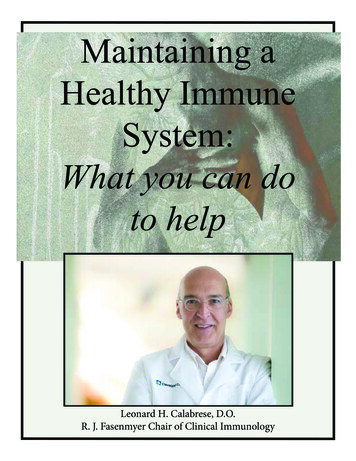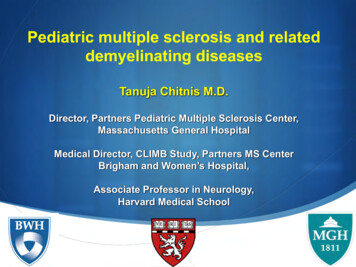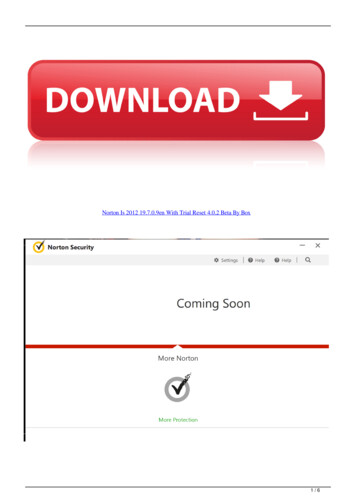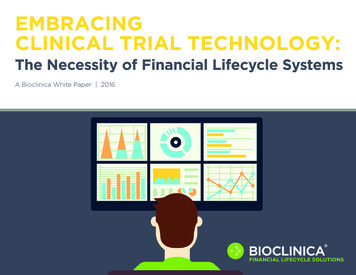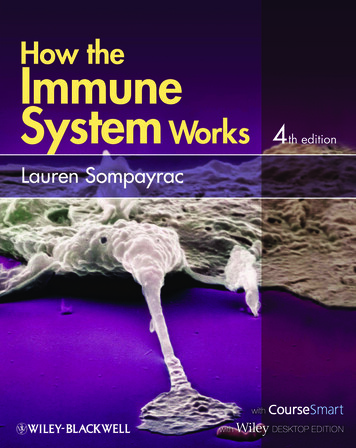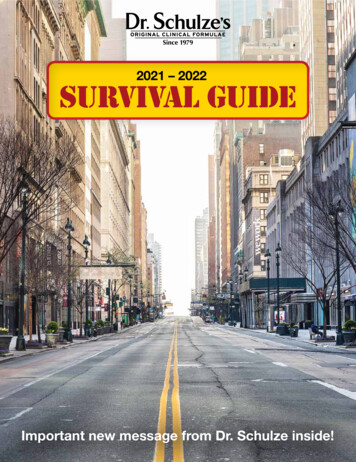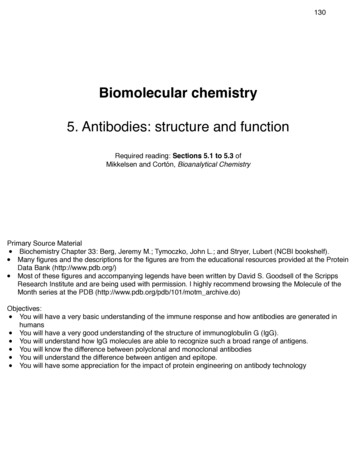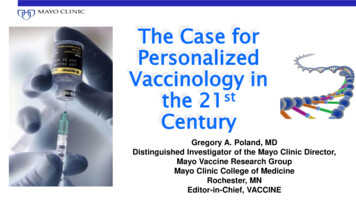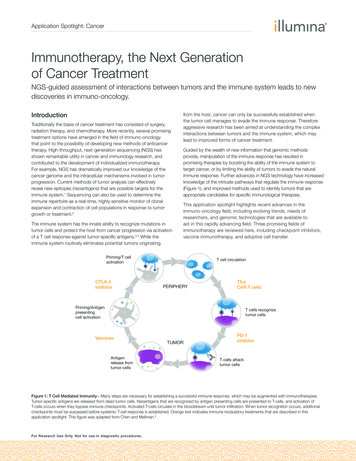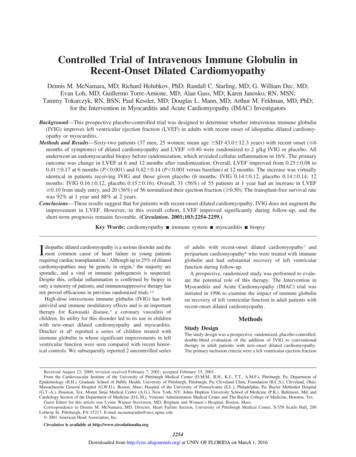
Transcription
Controlled Trial of Intravenous Immune Globulin inRecent-Onset Dilated CardiomyopathyDennis M. McNamara, MD; Richard Holubkov, PhD; Randall C. Starling, MD; G. William Dec, MD;Evan Loh, MD; Guillermo Torre-Amione, MD; Alan Gass, MD; Karen Janosko, RN, MSN;Tammy Tokarczyk, RN, BSN; Paul Kessler, MD; Douglas L. Mann, MD; Arthur M. Feldman, MD, PhD;for the Intervention in Myocarditis and Acute Cardiomyopathy (IMAC) InvestigatorsBackground—This prospective placebo-controlled trial was designed to determine whether intravenous immune globulin(IVIG) improves left ventricular ejection fraction (LVEF) in adults with recent onset of idiopathic dilated cardiomyopathy or myocarditis.Methods and Results—Sixty-two patients (37 men, 25 women; mean age SD 43.0 12.3 years) with recent onset (ⱕ6months of symptoms) of dilated cardiomyopathy and LVEF ⱕ0.40 were randomized to 2 g/kg IVIG or placebo. Allunderwent an endomyocardial biopsy before randomization, which revealed cellular inflammation in 16%. The primaryoutcome was change in LVEF at 6 and 12 months after randomization. Overall, LVEF improved from 0.25 0.08 to0.41 0.17 at 6 months (P 0.001) and 0.42 0.14 (P 0.001 versus baseline) at 12 months. The increase was virtuallyidentical in patients receiving IVIG and those given placebo (6 months: IVIG 0.14 0.12, placebo 0.14 0.14; 12months: IVIG 0.16 0.12, placebo 0.15 0.16). Overall, 31 (56%) of 55 patients at 1 year had an increase in LVEFⱖ0.10 from study entry, and 20 (36%) of 56 normalized their ejection fraction (ⱖ0.50). The transplant-free survival ratewas 92% at 1 year and 88% at 2 years.Conclusions—These results suggest that for patients with recent-onset dilated cardiomyopathy, IVIG does not augment theimprovement in LVEF. However, in this overall cohort, LVEF improved significantly during follow-up, and theshort-term prognosis remains favorable. (Circulation. 2001;103:2254-2259.)Key Words: cardiomyopathy 䡲 immune system 䡲 myocarditis 䡲 biopsyIof adults with recent-onset dilated cardiomyopathy7 andperipartum cardiomyopathy8 who were treated with immuneglobulin and had substantial recovery of left ventricularfunction during follow-up.A prospective, randomized study was performed to evaluate the potential role of this therapy. The Intervention inMyocarditis and Acute Cardiomyopathy (IMAC) trial wasinitiated in 1996 to examine the impact of immune globulinon recovery of left ventricular function in adult patients withrecent-onset dilated cardiomyopathy.diopathic dilated cardiomyopathy is a serious disorder and themost common cause of heart failure in young patientsrequiring cardiac transplantation.1 Although up to 25% of dilatedcardiomyopathies may be genetic in origin,2 the majority aresporadic, and a viral or immune pathogenesis is suspected.Despite this, cellular inflammation is confirmed by biopsy inonly a minority of patients, and immunosuppressive therapy hasnot proved efficacious in previous randomized trials.3,4High-dose intravenous immune globulin (IVIG) has bothantiviral and immune modulatory effects and is an importanttherapy for Kawasaki disease,5 a coronary vasculitis ofchildren. Its utility for this disorder led to its use in childrenwith new-onset dilated cardiomyopathy and myocarditis.Drucker et al6 reported a series of children treated withimmune globulin in whom significant improvements in leftventricular function were seen compared with recent historical controls. We subsequently reported 2 uncontrolled seriesMethodsStudy DesignThe study design was a prospective, randomized, placebo-controlled,double-blind evaluation of the addition of IVIG to conventionaltherapy in adult patients with new-onset dilated cardiomyopathy.The primary inclusion criteria were a left ventricular ejection fractionReceived August 23, 2000; revision received February 7, 2001; accepted February 15, 2001.From the Cardiovascular Institute of the University of Pittsburgh Medical Center (D.M.M., R.H., K.J., T.T., A.M.F.), Pittsburgh, Pa; Department ofEpidemiology (R.H.), Graduate School of Public Health, University of Pittsburgh, Pittsburgh, Pa; Cleveland Clinic Foundation (R.C.S.), Cleveland, Ohio;Massachusetts General Hospital (G.W.D.), Boston, Mass; Hospital of the University of Pennsylvania (E.L.), Philadelphia, Pa; Baylor Methodist Hospital(G.T.-A.), Houston, Tex; Mount Sinai Medical Center (A.G.), New York, NY; Johns Hopkins University School of Medicine (P.K.), Baltimore, Md; andCardiology Section of the Department of Medicine (D.L.M.), Veterans Administration Medical Center and The Baylor College of Medicine, Houston, Tex.Guest Editor for this article was Lynne Warner Stevenson, MD, Brigham and Women’s Hospital, Boston, Mass.Correspondence to Dennis M. McNamara, MD, Director, Heart Failure Section, University of Pittsburgh Medical Center, S-558 Scaife Hall, 200Lothrop St, Pittsburgh, PA 15213. E-mail mcnamaradm@msx.upmc.edu 2001 American Heart Association, Inc.Circulation is available at http://www.circulationaha.org2254Downloaded from http://circ.ahajournals.org/ at UNIV OF FLORIDA on March 1, 2016
McNamara et al(LVEF) ⱕ0.40, an evaluation consistent with either idiopathicdilated cardiomyopathy or myocarditis, and no more than 6 monthsof cardiac symptoms at the time of randomization. All patientsunderwent angiography or noninvasive screening to exclude coronary artery disease, a transthoracic echocardiogram to rule outsignificant valvular disease, and a right ventricular endomyocardialbiopsy before enrollment. Patients with significant diabetes (requiring therapy with insulin or an oral agent for more than 1 year),significant hypertension (diastolic pressure 95 mm Hg or systolicpressure 160 mm Hg) or uncorrected thyroid disease were excluded. Patients with and without cellular inflammation on biopsywere eligible for inclusion; however, patients with giant cell myocarditis, sarcoid, or hemochromatosis were excluded.Treatment-group assignment was performed with a blockedrandomization scheme (initial block of 2 treatment assignmentsfollowed by blocks of 4) stratified by clinical center. Patientsrandomized to the treatment group received a total of 2 g/kg IVIG(Gamimune N, 10%, Bayer Corporation). This was administeredat 1 g/kg IV each day on 2 consecutive days. Patients randomizedto placebo received 0.1% albumin in 10% maltose solution givenin an equivalent volume (10 mL/kg IV each day on 2 consecutivedays).TABLE 1.Immune Globulin in New-Onset CardiomyopathyFunctional Assessment and Follow-UpLVEF was assessed at baseline by radionuclide angiography, whichwas repeated at 6 and 12 months after randomization. Left ventricular dimensions were assessed by transthoracic echocardiogrambefore randomization. Patients not on mechanical support had anassessment of functional capacity by metabolic stress testing atbaseline, as well as a 6-minute walk test. Metabolic stress testing wasrepeated 12 months after randomization, and the 6-minute walk wasrepeated at 1, 6, and 12 months.Patients were seen during follow-up at 1, 6, and 12 months afterrandomization at the enrolling IMAC center. Patients were followedup at 6-month intervals after the first year, and the occurrence of thesecondary end point of death, cardiac transplantation, or need for leftventricular assist device (LVAD) was noted. Follow-up for secondary end-point status was 100% complete as of June 1999.Statistical AnalysisThe primary end point was predetermined as the change in LVEFfrom baseline to 6 and 12 months after randomization. Secondaryend points were event-free survival (events defined as death, cardiactransplantation, or placement of an LVAD) and comparison offunctional capacity as assessed by metabolic stress testing at 12IMAC Study Population Baseline EvaluationIVIG(n 33)Placebo(n 29)All Patients(n 62)Demographics/symptomsAge, y42.1 12.144.0 12.643.0 12.3Female, n (%)14 (42.4)11 (37.9)25 (40.3)Nonwhite, %12.110.311.3NYHA class, % I/II/III/IV3/42/48/617/48/21/1410/45/35/10Duration of symptoms, mo1.8 1.42.2 1.52.0 1.563.662.162.916.3 10.015.6 10.216.0 10.08.0 6.86.3 5.17.2 6.12.45 0.64Flulike illness before symptoms, %Right heart catheterization and rightventricular biopsyPCWP, mm Hg (n 61)RA, mm Hg (n 61) 1CI, L 䡠 min 2䡠m(n 59)2.47 0.652.43 0.63Abnormal biopsy, %75.886.280.6Fibrosis, %57.669.062.9Hypertrophy, %42.458.650.083.9Cellular inflammation, %Absent225584.882.8Nonspecific inflammation3.06.94.8Borderline myocarditis6.13.44.8Myocarditis6.16.96.5LVEF (n 61)0.25 0.080.25 0.090.25 0.08RVEF (n 48)0.32 0.110.36 0.120.34 0.11LV diastolic diameter, cm (n 60)6.63 0.996.65 0.846.64 0.92Peak V̇O2, mL 䡠 min 1 䡠 kg 1 (n 56)19.2 6.219.7 5.519.5 5.8% Predicted peak V̇O2 (n 56)72.2 17.573.1 30.472.7 24.4Radionuclide angiographyEchocardiogram/peak V̇O2RA indicates right atrial pressure; CI, cardiac index; RVEF, right ventricular ejection fraction; peakV̇O2, peak oxygen consumption; and LV, left ventricle.Continuous data are expressed as mean SD.No statistically significant differences were found between the treatment groups with respect tothese characteristics.Downloaded from http://circ.ahajournals.org/ at UNIV OF FLORIDA on March 1, 2016
2256CirculationMay 8, 2001months after randomization. The study’s planned sample size of 30patients in each treatment arm was calculated to provide 80% powerto detect a treatment difference in ejection fraction (EF) changescores of ⱖ8% assuming a within-treatment standard deviation of10%, using a 2-sided test with significance level of 0.05. Theseprojected differences and variability estimates were based on resultsreported from the myocarditis treatment trial,4 as well as 2 previousretrospective studies of recent-onset dilated cardiomyopathy.9,10For association of treatment with discrete factors, the 2 test wasused for dichotomous factors and the Mantel-Haenszel test forordered categorical factors. For continuous parameters, the overallsignificance of change from baseline to a follow-up time point wasassessed with the Wilcoxon signed rank test, and change scores werecompared between treatment groups with the Wilcoxon rank-sumtest. Significance of change in 6-minute walk distance over the entirecourse of follow-up was assessed nonparametrically with the Pagetest.11 Associations between continuous parameters were assessedvia Spearman correlation coefficient. Association of continuousmeasures with ordered categorical variables such as New York HeartAssociation (NYHA) class was assessed with the JonckheereTerpstra test.12 Event rates over time were assessed by the KaplanMeier method, and the resulting freedom-from-event curves werecompared via the log-rank test.LVEF by radionuclide scan was not available at baseline for 1patient who was randomized to placebo whose LVEF was 0.30 byleft ventricular angiography. This patient has been excluded fromanalyses involving baseline EF data including the primary end point;deletion of this patient from these analyses did not affect the studyfindings. This patient has been included in all analyses not involvingbaseline EF.ResultsSixty-two adult patients (mean age 43.0 12.3 years) wereenrolled at 6 centers between February 1996 and May 1998.The demographics and clinical characteristics of the patientsare listed by treatment group in Table 1. Mean LVEF at studyentry was 0.25 0.08, and mean left ventricular end-diastolicdiameter was 6.6 0.9 cm. Mean duration of symptoms at thetime of randomization was 2.0 1.5 months. Ten (16%) of 62patients had cellular inflammation on endomyocardial biopsy,including 4 patients with myocarditis and 3 with borderlinemyocarditis by the Dallas criteria,13 as well as 3 withnonspecific inflammation (eg, perivascular lymphocytic infiltration). Although the majority of patients (81%) wereNYHA class II or III, 15 (10 IVIG, 5 placebo) requiredinotropic support and 2 (1 IVIG, 1 placebo) required intraaortic balloon pump support at the time of initiation of studydrug. In contrast, 6 patients (1 IVIG, 5 placebo) were NYHAclass I at the time of randomization. There were no significantdifferences between treatment groups with respect to any ofthe clinical parameters measured. Conventional therapy at thetime of randomization included ACE inhibitors in 56 patients(90%) and -blocker in 11 patients (18%). There were noadverse events attributed to study drug in either treatmentgroup. Eleven of 33 patients who received IVIG reportedminor side effects, predominantly transient flulike symptomsor headache, which were reported in none of the 29 patientswho received placebo.Effect of Therapy on Left Ventricular FunctionMean LVEF for all patients improved significantly from0.25 0.08 at baseline to 0.41 0.17 at 6 months (P 0.001)and 0.42 0.14 at 12 months after randomization (P 0.001compared with baseline, P NS compared with 6 months).Figure 1. LVEF over time by treatment: LVEF by radionuclidescan at baseline and 12 months after randomization in patientsrandomized to placebo and IVIG. Overall, LVEF improved significantly over time (12-month LVEF significantly higher than baseline, P 0.001). However, no differences by treatment groupwere evident (P NS for comparisons by treatment).The substantial average improvement seen in patients whoreceived IVIG was virtually identical to that for patients whoreceived the placebo infusion (Figure 1). Most of the improvement occurred within the first 6 months, as the meanincrease in LVEF from baseline was 14 13 EF units at 6months and 15 14 EF units at 12 months. No effect oftreatment was evident (increase in LVEF at 6 months:IVIG 0.14 0.12, placebo 0.14 0.14; 12 months:IVIG 0.16 0.12, placebo 0.15 0.16).Functional CapacityAmong patients with data at baseline and 12 months (n 48),peak oxygen consumption (peak V̇O2) as assessed by metabolic stress testing increased significantly over time from20.2 5.7 mL · kg 1 · min 1 at baseline to 23.0 7.1 mL · kg 1· min 1 at 1 year (P 0.001). No effect of therapy onimprovement in functional capacity was evident (peak V̇O2 atbaseline: IVIG 20.0 5.9, placebo 20.4 5.6; at 12 months:IVIG 22.5 6.5, placebo 23.7 7.8; P NS for effect oftherapy on improvements over time). Examination of6-minute walk data (n 42) demonstrated that functionalimprovement occurred as early as 1 month and peaked by 6months (distance walked within 6 minutes in meters: baseline386.4 171.1, 1 month 452.3 162.1, 6 months 498.0 178.0,and 12 months 493.5 179.2; P 0.001 for test of changeover time, no treatment effect evident in subset analysis).Event-Free SurvivalA total of 9 patients had secondary events during follow-up,including 6 IVIG patients (3 deaths, 2 transplants, and 1LVAD placement with subsequent transplant) and 3 patientsassigned to placebo (1 death, 1 transplant, and 1 LVADplacement). Patients without events were followed up for amedian of 23 months (range 14 to 41 months). The overallevent rate was low, with a 1-year Kaplan-Meier event-freesurvival rate of 91.9% and a 2-year rate of 88.4%. Nosignificant difference in event-free survival was seen bytreatment (P 0.39 for comparison of event-free survival bylog-rank test).Downloaded from http://circ.ahajournals.org/ at UNIV OF FLORIDA on March 1, 2016
McNamara et alImmune Globulin in New-Onset Cardiomyopathy2257Figure 2. LVEF at baseline and 12 months after randomizationby NHYA class at presentation. Patients with baseline and12-month multigated acquisition scan data only. Higher NYHAfunctional class at entry was significantly associated with lowerLVEF at baseline (P 0.02), but there was a nonsignificant trendtoward higher LVEF at 12 months. *Another NYHA class IVpatient, excluded from this analysis because baseline LVEF(0.30) was determined by ventricular angiography, had LVEF of0.69 at 1 year after randomization.Predictor of Outcome by Baseline ParametersNYHA Class at EntryThirty-four patients were NYHA class I or II at entry,whereas 28 were class III or IV. Higher NYHA class at entrywas associated with lower baseline LVEF (P 0.02) but atrend toward higher LVEF at 1 year (Figure 2). In part, thismay represent a “survivor effect,” because of the 6 patientswho died or received a transplant during the first year, all but1 were class NYHA III or IV at presentation (percentage ofpatients alive and event-free at 1-year follow-up for NYHAclass I, II, III, and IV was 100%, 96%, 86%, and 67%,respectively).Endomyocardial BiopsyTwo (20%) of 10 patients with cellular inflammation onendomyocardial biopsy had events during the first year versus4 (8%) of 52 of those with negative biopsies. Histologicalfindings on biopsy (the presence or absence of cellularinflammation, fibrosis, or hypertrophy) also did not predictsubsequent improvements in LVEF (Table 2). Of patientsTABLE 2. Baseline and 12-Month LVEF and Change in LVEFOver Time, According to Biopsy StatusBaselineLVEF12-MonthLVEFChangeOver TimeCellular inflammationat biopsyFigure 3. A, LVEF at baseline, 6 months, and 12 months by tertiles of functional capacity by metabolic stress testing (peakV̇O2) at time of entry. Peak V̇O2 at entry was not associated withLVEF at baseline or at 6 or 12 months after randomization(P NS). B, LVEF at baseline, 6 months, and 12 months by tertiles of PCWP at time of entry. Higher PCWP at entry was associated with lower LVEF at baseline (P 0.001), but no differenceswere noted at 6 or 12 months (P NS).whose LVEF normalized (ⱖ0.50) at 1 year, 16 of 20 hadbiopsies that were negative for cellular inflammation. Theoverall increase in LVEF at 12 months was 0.21 0.14 inpatients with cellular inflammation and 0.15 0.14 amongthose with negative biopsies (P 0.27).Hemodynamic Assessment and Functional TestingBaseline hemodynamic assessment (pulmonary capillarywedge pressure [PCWP]) and metabolic stress testing (peakV̇O2) did not correlate with either 12-month LVEF (r 0.18and 0.02, respectively; P NS) or change from baseline to 12months (r 0.04 and 0.04, respectively; P NS). In asimilar fashion, examination of tertiles of peak V̇O2 (Figure3A) or PCWP (Figure 3B) did not suggest any predictivevalue with respect to subsequent LV recovery.DiscussionAbsent (n 52)0.25 0.090.41 0.140.15 0.14Present (n 10)0.25 0.080.49 0.190.21 0.14Absent (n 23)0.26 0.080.43 0.130.16 0.12Present (n 39)0.25 0.090.41 0.150.15 0.15Absent (n 31)0.26 0.090.44 0.140.17 0.14Present (n 31)0.24 0.080.40 0.150.13 0.14Fibrosis at biopsyHypertrophy atbiopsyNo statistically significant differences were found between subgroups withrespect to these outcomes.Despite the potential therapeutic efficacy suggested by previous uncontrolled studies, treatment of adult patients withrecent-onset cardiomyopathy with immune globulin in thisplacebo-controlled trial did not affect improvements in LVEFor functional capacity during follow-up. Although the meanimprovement in EF at 1 year of 16 EF units in the treatedgroup was similar to that seen in the previous pilot study, thisincrease was essentially equaled by patients who were givenplacebo. This high rate of spontaneous recovery with conventional therapy was greater than anticipated but most likelyunderlies the apparent improvement reported in previousuncontrolled reports.Downloaded from http://circ.ahajournals.org/ at UNIV OF FLORIDA on March 1, 2016
2258CirculationMay 8, 2001The overall improvement in LVEF for the entire IMACstudy population exceeded that seen in the MyocarditisTreatment Trial,4 the largest randomized and placebocontrolled trial testing the effects of immunosuppression(prednisone and cyclosporine) in patients with presumedmyocarditis. Our study population differed from the Myocarditis Treatment Trial in that only 10 of 62 patients had cellularinflammation on their endomyocardial biopsy, and 7 wereclassified as having myocarditis (or borderline) by the Dallascriteria.13 However, our data also suggest that the improvements in EF were similar in patients with and without cellularinflammation. Therefore, the difference in biopsy status isunlikely to explain the difference between the improvementseen in the present study and the previous trial. A moreimportant distinction may be the duration of symptoms. Allpatients in the present study had 6 months of symptoms,whereas those in the Myocarditis Treatment Trial could havea history of heart failure for up to 2 years beforerandomization.Previous retrospective studies have also shown significantimprovements in LVEF for patients with recent-onset dilatedcardiomyopathy. Dec et al,9 more than a decade ago, foundthat one third of patients with acute dilated cardiomyopathy(defined as 6 months of symptoms) had improvement ofⱖ10 EF units on follow-up. Similarly, a review of patientswith dilated cardiomyopathy referred to the University ofCalifornia at Los Angeles for cardiac transplant evaluationwithin 6 months of onset found that 29% had an improvementof ⱖ15 EF units.10 By comparison, 31 (56%) of 55 IMACpatients had improvement of ⱖ10 EF units noted by 12month follow-up, and 20 (36%) of 56 evaluated at 1 yearachieved a final EF of ⱖ0.50, essentially normalizing theirventricular systolic function.The 2 previous studies9,10 of recent-onset cardiomyopathypredated the use of -adrenergic antagonists in patients withheart failure.14 Therefore, the improved natural history ofacute dilated cardiomyopathy suggested by the present studymay be attributed in part to the emerging role of these agentsin the management of patients with systolic dysfunction.Indeed, although only 18% of the IMAC population weregiven -blockers at baseline, this proportion increased to 45%by the 12-month postrandomization visit.Although advances in conventional medical therapy haveimproved outcomes for patients with new-onset dilated cardiomyopathy, its origin remains elusive. The low prevalenceof myocarditis on biopsy in this group of patients withpresumed myocarditis is consistent with previous studies.4Although endomyocardial biopsy remains the “gold standard” for the diagnosis of myocarditis, sampling error andvariability in histological interpretation markedly limit itssensitivity and diagnostic utility. Histology did not predictoutcomes for the IMAC patients. Indeed, 75% (16/20) ofthose patients who normalized their LVEF during follow-uphad biopsies at entry that were negative for cellular inflammation. Many of these patients likely did have transientmyocardial inflammation despite their negative histology,and better methodologies are needed to more accuratelydiagnose such patients at the time of presentation.The present study cannot address the use of immuneglobulin for the treatment of myocarditis and new-onsetdilated cardiomyopathies in children. In the previous pediatric study,6 this illness in children was more frequentlyassociated with a positive endomyocardial biopsy, febrileillness, and a short duration of symptoms, measured in daysto weeks rather than months. Children appear more likelythan adults to present in the earlier inflammatory stage of theillness, and animal studies of the effects of immune globulinon virally induced cardiomyopathy show the drug is mosteffective when given during the early viremic phase.15,16Thus, failure of the IMAC study to prove efficacy for IVIG inthe adult population does not rule out the potential effectiveness of immune globulin in children with a similar butpotentially pathologically distinct disorder. However, ourresults do suggest that a prospective randomized study maybe warranted in children to truly evaluate the potentialefficacy of immune globulin in the pediatric population.The dosing schedule of a single administration of 2 g/kg IVIGevaluated in the present study was based on its use in Kawasakidisease and myocarditis disorders in children,5,6 as well as initialpilot studies.7,8 When immune globulin is given as high-doseintravenous therapy, IgG levels generally return to baseline after30 days, and when used as an immune modulating agent forchronic disorders, monthly infusions are occasionally utilized.The present study does not evaluate the potential effectiveness ofa more prolonged dosing schedule. In addition, the magnitude ofimprovement for the control group was significantly greater thananticipated, and this may have limited the power of the study todetect subtler treatment differences.The present study did not demonstrate evidence of therapeutic efficacy for immune globulin administration for adultswith recent onset of dilated cardiomyopathy. However, treatment with standard therapies resulted in marked improvements in ventricular function in the majority of patients andnormalization in one third. Although we were unable todemonstrate a beneficial therapeutic role for immune globulin, these overall outcomes should give clinicians furthercause for optimism in the management of patients with thistraditionally devastating disorder.AppendixCenters and investigators participating in the Intervention in Myocarditis and Acute Cardiomyopathy (IMAC) trial: University ofPittsburgh Medical Center: D.M. McNamara, W.D. Rosenblum, R.J.Alvarez, Jr, G.A. MacGowan, S. Murali, A.M. Feldman, A.J.Demetris, F. Villanueva, K. Janosko, T. Tokarczyk; Cleveland ClinicFoundation: R. Starling, K. Kiefer; Massachusetts General Hospital:G.W. Dec, M.J. Semigran, T. DiSalvo, D. Cocca-Spofford; BaylorMethodist Hospital: G. Torre-Amione, M. Vooletich; Hospital of theUniversity of Pennsylvania: E. Loh, D. DeNofrio, A. Kao, K. Craig,F. Pickering; Mount Sinai Medical Center: A. Gass, J. Alexis; Dataand Safety Analysis: University of Pittsburgh Graduate School ofPublic Health and Johns Hopkins School of Medicine: R. Holubkov,P. Kessler.AcknowledgmentThis study was supported by an educational grant from the BayerCorporation.Downloaded from http://circ.ahajournals.org/ at UNIV OF FLORIDA on March 1, 2016
McNamara et alReferences1. Hosenpud JD, Bennete LE, Keck BM, et al. The registry of the International Society for Heart and Lung Transplantation: sixteenth officialreport—1999. J Heart Lung Transplant. 1999;18:611– 626.2. Michels VV, Moll PP, Miller FA, et al. The frequency of familial dilatedcardiomyopathy in a series of patients with idiopathic dilated cardiomyopathy. N Engl J Med. 1992;326:77– 82.3. Parrillo JE, Cunnion RE, Epstein SE, et al. A prospective, randomized,controlled trial of prednisone for dilated cardiomyopathy. N Engl J Med.1989;321:1061–1068.4. Mason JW, O’Connell JB, Herskowitz A, et al. A clinical trial of immunosuppressive therapy for myocarditis. N Engl J Med. 1995;333:269 –275.5. Newburger JW, Takahashi M, Burns JC, et al. The treatment of Kawasakisyndrome with intravenous gamma globulin. N Engl J Med. 1986;315:341–347.6. Drucker NA, Colan SD, Lewis AB, et al. Gammaglobulin treatment ofacute myocarditis in the pediatric population. Circulation. 1994;89:252–257.7. McNamara DM, Rosenblum WD, Janosko KM, et al. Intravenousimmune globulin in the therapy of myocarditis and acute cardiomyopathy.Circulation. 1997;95:2476 –2478.Immune Globulin in New-Onset Cardiomyopathy22598. Bozkurt B, Villaneuva FS, Holubkov R, et al. Intravenous immuneglobulin in the therapy of peripartum cardiomyopathy. J Am Coll Cardiol.1999;34:177–180.9. Dec GW, Palacios IF, Fallon JT, et al. Active myocarditis in the spectrumof acute dilated cardiomyopathies. N Engl J Med. 1985;312:885– 890.10. Steimle AE, Stevenson LW, Fonarow GC, et al. Prediction ofimprovement in recent onset cardiomyopathy after referral for hearttransplantation. J Am Coll Cardiol. 1994;23:553–559.11. Page EB. Ordered hypotheses for multiple treatments: a significance testfor linear ranks. J Am Stat Assoc. 1963;58:216 –230.12. Jonckheere AR. A distribution-free k-sample test against ordered alternatives. Biometrika. 1954;41:133–145.13. Aretz HT, Billingham ME, Edwards WD, et al. Myocarditis: histopathologic definition and classification. Am J Cardiovasc Pathol. 1987;1:3–14.14. Packer M, Bristow MR, Cohn JN, et al. The effect of carvedilol onmorbidity and mortality in patients with chronic heart failure. N EnglJ Med. 1996;334:1349 –1355.15. Weller AH, Hall M, Huber SA. Polyclonal immunoglobulin therapyprotects against cardiac damage in experimental coxsackievirus-inducedmyocarditis. Eur Heart J. 1992;13:115–119.16. Takada H, Kishimoto C, Hiraoka Y. Therapy with immunoglobulin suppresses myocarditis in a murine coxsackievirus B3 model. Circulation.1995;92:1604 –1611.Downloaded from http://circ.ahajournals.org/ at UNIV OF FLORIDA on March 1, 2016
Controlled Trial of Intravenous Immune Globulin in Recent-Onset Dilated CardiomyopathyDennis M. McNamara, Richard Holubkov, Randall C. Starling, G. William Dec, Evan Loh, GuillermoTorre-Amione, Alan Gass, Karen Janosko, Tammy Tokarczyk, Paul Kessler, Douglas L. Mann and ArthurM. Feldmanfor the Intervention in Myocarditis and Acute Cardiomyopathy (IMAC) InvestigatorsCirculation. 2001;103:2254-2259doi: 10.1161/01.CIR.103.18.2254Circulation is published by the American Heart Association, 7272 Greenville Avenue, Dallas, TX 75231Copyright 2001 American Heart Association, Inc. All rights reserved.Print ISSN: 0009-7322. Online ISSN: 1524-4539The online version of this article, along with updated information and services, is located on the WorldWide Web Permissions: Requests for permissions to reproduce figures, tables, or portions of articles originally published inCirculation can be obtained via RightsLink, a service of the Copyright Clearance Center, not the Editorial Office. Oncethe online version of the published article for which permission is being requested is located, click Request Permissions inthe middle column of the Web page under Services. Further information about this process is available in thePermissionsand Rights Question and Answer document.Reprints: Information about reprints can be found online at:http://www.lww.com/reprintsSubscriptions: Information about subscribing to Circulation is online loaded from http://circ.ahajournals.org/ at UNIV OF FLORIDA on March 1, 2016
Tammy Tokarczyk, RN, BSN; Paul Kessler, MD; Douglas L. Mann, MD; Arthur M. Feldman, MD, PhD; for the Intervention in Myocarditis and Acute Cardiomyopathy (IMAC) Investigators Background—This prospective placebo-controlled trial was designed to determine whether intravenous immune globulin
